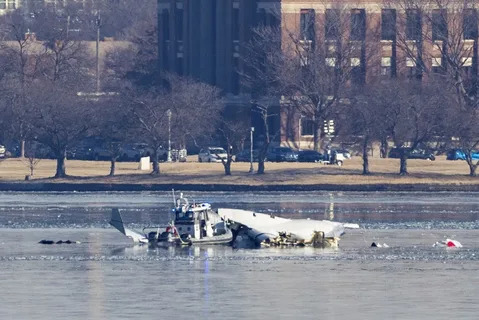My heart fell when I first learned about the American Airlines plane crash in D.C.
Although plane crashes are uncommon, they still raise a lot of questions.
What went wrong? Did anyone survive? What impact does this have on the safety of air travel?
You’re most likely searching for answers if you’re here.
Let’s get to the point—no jargon or filler, just the information and understanding you require.
Table of Contents
- What Happened in the American Airlines D.C. Plane Crash?
- Key Details of the Crash
- Was Anyone Injured or Killed?
- How Did the Authorities Respond?
- What Does This Mean for Air Travel Safety?
- FAQs About the American Airlines D.C. Plane Crash
- Final Thoughts
What Happened in the American Airlines D.C. Plane Crash?
A plane operated by American Airlines crashed close to Washington, D.C., on what appeared to be a typical day, rocking the country.
Over the Potomac River, the aircraft—which was a smaller private plane—slammed into a helicopter.
This is a reminder of how erratic life can be, not just another news item.
One of the busiest airports in the United States, Reagan National Airport, is near where the crash occurred.
Emergency personnel raced to the scene after witnesses reported seeing the plane crash.
Key Details of the Crash
Let’s get into the specifics:
- Location: Potomac River, close to Virginia’s Arlington.
- Aircraft Involved: A helicopter and a private jet.
- Time of Incident: early in the afternoon, when the sky is clear.
- Cause: Investigations are ongoing, but preliminary reports point to a collision in midair.
The fact that this occurred in a heavily watched airspace is shocking.
The investigation to identify the precise cause is being led by the National Transportation Safety Board (NTSB).
Was Anyone Injured or Killed?
Everyone has this question on their minds.
Unfortunately, there were deaths.
The passengers in the helicopter and the private plane’s pilot were killed.
The possibility of additional casualties was reduced because neither aircraft carried passengers.
However, one lost life is too many.
How Did the Authorities Respond?
The reaction was well-coordinated and quick.
- Emergency Services: arrived in a matter of minutes to secure the area and look for survivors.
- FAA and NTSB: started an investigation right away to try to piece together what had happened.
- Local Authorities: Potomac River sections were blocked off for recovery efforts.
In situations like this, prompt action is essential.
It guarantees the preservation of evidence and provides families with the answers they are entitled to.
What Does This Mean for Air Travel Safety?
When a crash occurs, people naturally wonder if flying is safe.
The fact remains that flying remains one of the safest modes of transportation.
Nevertheless, instances such as these point out areas that require improvement:
- Air Traffic Control: Could this have been avoided with improved communication?
- Pilot Training: Is there a lack of emergency response training?
- Regulations: Do private planes operating close to major airports require more stringent regulations?
The NTSB’s conclusions will probably result in suggestions for averting future tragedies of this nature.
FAQs About the American Airlines D.C. Plane Crash
1. Was this an American Airlines commercial flight?
No, the aircraft was private. Although American Airlines was not directly involved, the accident has sparked more general worries about the safety of air travel.
2. How common are mid-air collisions?
incredibly uncommon. Mid-air collisions are rare because of stringent regulations and advanced technology.
3. What should I do if I’m worried about flying after this?
Anxiety is common, but keep in mind that flying is statistically safer than driving. Reputable airlines should be used, and you should have faith in the safety procedures.
4. Will this crash affect flights at Reagan National Airport?
While investigations may cause brief disruptions, operations usually quickly resume.
Final Thoughts
The tragic American Airlines plane crash in Washington, D.C., serves as a reminder of the dangers of flying, no matter how minor.
However, it also demonstrates how crucial it is to keep improving aviation safety.
Let’s support safer skies in remembrance of the lives lost while we await the NTSB’s final report.
Leave a comment below if you have any additional queries or ideas.
Let’s continue the discussion.
The Broader Impact of the Crash
The impact of a plane crash extends beyond the relatives of the individuals involved.
Both the public’s opinion of flying and the aviation sector as a whole are affected.
Here’s how this incident could have a broader impact:
1. Public Confidence in Air Travel
Such incidents have the potential to erode public confidence in aviation.
However, it’s crucial to keep in mind that flying is still very safe.
Being in a plane crash has a 1 in 11 million chance.
In contrast, the odds of dying in a car accident are 1 in 5,000.
2. Changes in Regulations
New rules for private aircraft may result from the NTSB’s investigation.
This could involve better training for pilots or more stringent regulations for flying close to crowded airports.
3. Impact on Reagan National Airport
A significant hub for both private and commercial aviation is Reagan National Airport.
Even though there were no commercial aircraft involved in the crash, it might influence how the airport handles air traffic.
Stories from the Scene
Witnesses’ and first responders’ accounts frequently provide a more lucid picture when something similar occurs.
A witness reported seeing debris fall into the Potomac River and hearing a loud bang.
Another reported witnessing the helicopter go out of control and crash.
To recover the wreckage and make sure the public was safe, first responders put in endless effort.
They should be commended for their courage and promptness.
Lessons We Can Learn
Every tragedy has a lesson to teach.
What we can learn from the American Airlines plane crash in D.C. is as follows:
1. The Importance of Communication
Pilots and air traffic control must communicate clearly.
A minor misunderstanding can have disastrous results.
2. The Need for Better Technology
Even though flying is safe, it can always be made better.
Investing in improved collision avoidance and tracking technology could save lives.
3. The Value of Preparedness
This is the kind of scenario that emergency responders are trained for, and their readiness helped.
It serves as a reminder of how crucial it is to be prepared for anything.
How You Can Stay Safe While Flying
Following this incident, the following advice may help you feel less anxious when flying:
- Choose Reputable Airlines: Choose reputable airlines with solid safety records.
- Pay Attention to Safety Briefings: Despite their apparent repetition, they are crucial.
- Trust the Professionals: To ensure your safety, pilots and air traffic controllers undergo extensive training.
The Role of the NTSB
When it comes to looking into aircraft accidents, the National Transportation Safety Board (NTSB) is essential.
What they do is as follows:
- Gather Evidence: They gather information from witness reports, flight recorders, and the wreckage.
- Analyze Data: They make use of this data to identify the crash’s cause.
- Make Recommendations: They recommend modifications to enhance safety in light of their findings.
The work of the NTSB is essential to averting accidents in the future.
A Look at Past Plane Crashes
Although they are uncommon, plane crashes do occur.
Here are some noteworthy examples along with the lessons we took away:
- Tenerife Airport Disaster (1977): Miscommunication led to the deadliest aviation accident in history.
- Lesson: Effective communication is crucial.
- US Airways Flight 1549 (2009): After a water landing, all of the passengers survived the “Miracle on the Hudson.”
- Lesson: Quick thinking and proper training can save lives.
- Asiana Airlines Flight 214 (2013): an accident brought on by a pilot’s mistake during landing.
- Lesson: Pilots must receive ongoing training.
The Future of Air Travel Safety
To make air travel safer, the aviation sector is always changing.
What lies ahead is as follows:
- Advanced Collision Avoidance Systems: Pilots can avoid mid-air collisions with the aid of new technology.
- Improved Pilot Training: Training programs and simulators are getting increasingly sophisticated.
- Stricter Regulations: Governments are enforcing stricter regulations on both commercial and private aviation.
Final Thoughts
The tragic American Airlines plane crash in Washington, D.C., serves as a reminder of the dangers associated with flying.
However, it also serves as a wake-up call to increase security and stop accidents in the future.
Let’s support safer skies in remembrance of the lives lost while we await the NTSB’s final report.
Leave a comment below if you have any additional queries or ideas.
Let’s continue the discussion.



